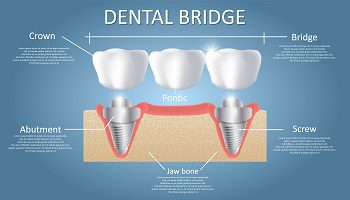How Do Fixed Bridges Work?
According to the American Dental Association, the average adult has at least three decayed or missing teeth. Therefore, people used restorative method...

According to the American Dental Association, the average adult has at least three decayed or missing teeth. Therefore, people used restorative methods to ensure tooth functionality to fill this gap. There can be various options for doing this process, and fixed bridges are the most widely used ones. In this article, we will discuss the principles and how do fixed bridges work and throw light on what to expect from this treatment. So, let’s get started.
Working Principles of Fixed Bridges:
A Fixed bridge is tooth-colored and works just like natural teeth. It is super easy to maintain and does not fall out of place compared to partial dentures. It is fixed in the mouth to ease up the patient’s tasks, and he can sleep and eat with it comfortably.
Fixed bridges work in a way that they fill the gap created by the missing teeth. It does this by securing a false tooth to the surrounding teeth, which acts as a bridge between their healthy teeth. The surrounding teeth help protect and hold the bridge to the maximum extent. The patient can easily chew and smile with confidence.
Bridge placement is not a surgical procedure, and the patient stays awake during the treatment. However, the dentist might use mild sedation to relax the patient, especially if he becomes anxious. The dentist will use local anesthesia to numb the area of the mouth, and the medication will be injected directly into the gums.
Then, the supporting teeth will be prepared to make room for the crown placement. Afterward, the dentist will take an impression of the teeth. It is sent to the laboratory to create a custom bridge. The dentist will then make a temporary bridge to protect the patient’s mouth. The temporary bridge is then replaced by the permanent bridge on the next dental visit. It is carefully cemented to ensure the best results.

What to Expect from This Treatment?
After the dental bridge procedure is done, the patient might feel numb for a few hours. The numbness is felt in the tongue, gums, and mouth because of the local anesthesia. Patients might also feel some tenderness, and there is a minor sensitivity to hot and cold items for a few days. A modest amount of discomfort can be there, and you can approach your dentist if they reach a concerning level. However, you can gargle by mixing four ounces of warm water and one tablespoon of salt to ease up any discomfort.
Maintaining dental hygiene is a crucial factor in ensuring the bridge’s success. So, take care of your dental bridge to enjoy your life.
Final Thoughts
Fixed bridge treatment helps you to feel more confident about your smile and dental health. They are highly stable and durable appliances that offer numerous benefits to patients. If you plan to restore your tooth with this treatment, consult a dentist near you to do the procedure. Goodluck.
To find out more about Fixed Bridges, Contact your Walnut Creek Dentist, Dr. Tiziana Procopio Towle, DDS at Procopio Towle Dental Office.
Resource:
*Neither this nor any other content in this media is meant to prescribe, recommend, or prevent any treatment or procedure. We highly recommend that you get the advice of a qualified dentist or other medical practitioners regarding your specific dental condition.
Get to know us
The best and gentle Dentists and Team Member of Procopio Towle Dental Office are dedicated to providing top quality dental care to patients in Walnut Creek the surrounding San Francisco Bay Area.
Meet Our Dentist



